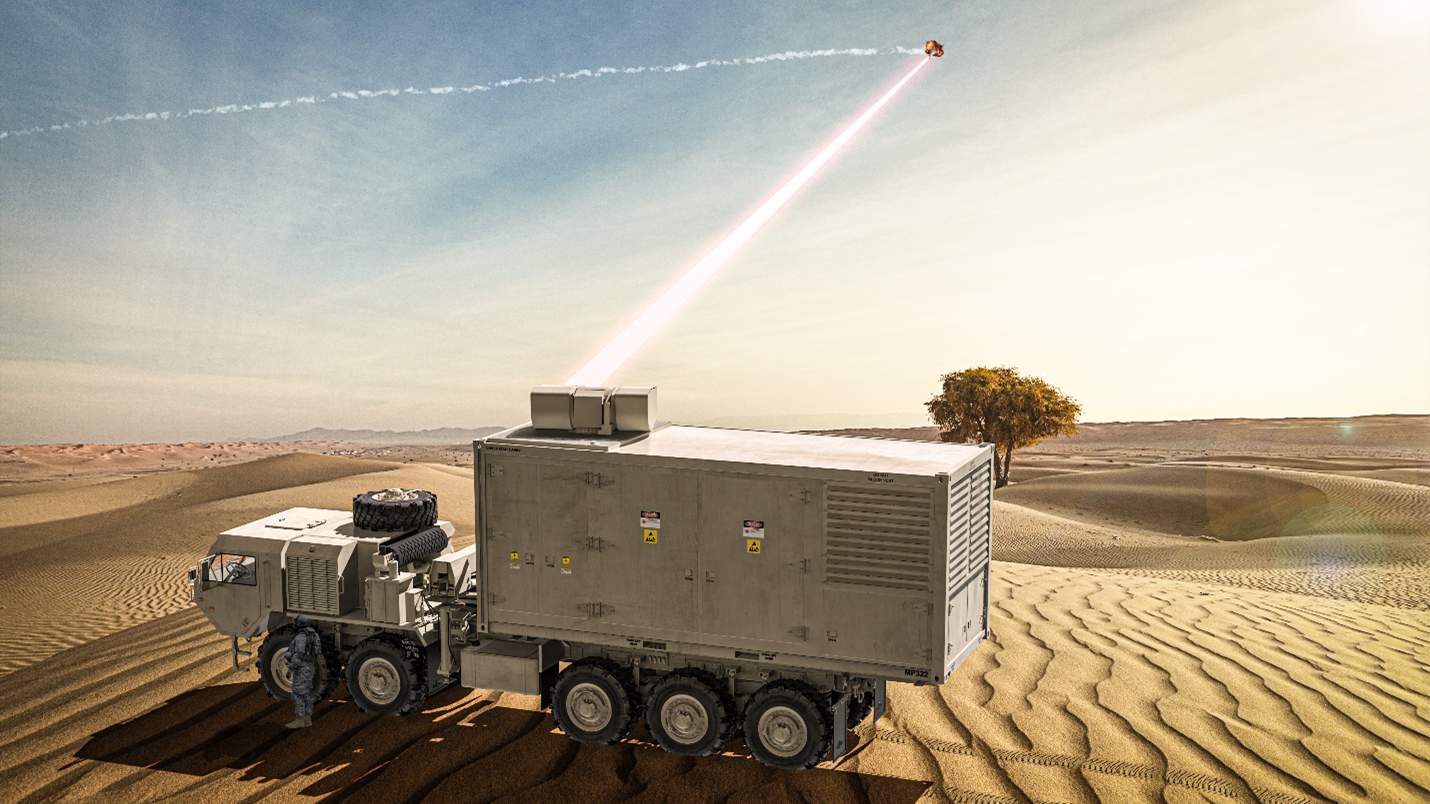
Concept art for Lockheed Martin’s offering to the U.S. Army’s Indirect Fires Protection Capability-High Energy Laser (IFPC-HEL) Demonstrator laser weapon system. (Image courtesy Lockheed Martin)
WASHINGTON — With directed-energy research now coming to fruition, the Missile Defense Agency is putting “increased emphasis” on development of directed-energy weapons for shooting down adversary missiles, according to a senior MDA official.
“I think part of [why] the Missile Defense Agency in the past few years kind of backed away was that technology needed still needed to mature. It needed to mature in power levels that could be delivered on target, and needed to mature and reduction of the size, weight and power requirements to produce the directed-energy effects,” explained Laura DeSimone, MDA executive director, in an online interview with Defense News today.
The Defense Department has run hot and cold on lasers and high-powered microwaves for missile defense since the dawn of Ronald Reagan’s Strategic Defense Initiative 40 years ago. In recent years, there was a burst of interest driven by Congress in 2015 that subsequently died down, only to be re-ignited during the Trump administration by then-Pentagon director of research and engineering Mike Griffin. The problem has simply been that the technology hasn’t been ready for prime time.
However in recent months, the agency has seen “that technology maturation is happening,” DeSimone said, including at the US national laboratories, the Department of Energy and within industry.
“I mean, there have been some really impressive results,” DeSimone said. “We’ve been doing studies all along, and looking at lethality effects and doing experimentation. But we think that, finally, we’re starting to see some real progress and, and so that’s why the increased emphasis.”
The Biden administration’s Missile Defense Review issued last October noted the need for “non-kinetic” options in light of changing threats, and the Defense Department over the past several years has ramped up funding for numerous research and development efforts on high-energy lasers and microwave weapons. The systems involve defense against both missiles and drones, with the Army in the forefront of testing laser weapons.
Of course, laser systems aren’t only of interest in the US. Israel’s Iron Beam effort, a laser-based variant of the Iron Dome system, is inching towards active deployment, while the United Kingdom’s DragonFire effort has successfully taken out small drones in tests. But by sheer dollars, the Pentagon is always going to be a driving force in making the widespread use of directed energy a reality.
“Directed energy shows great promise for the future. I mean, there’s so many advantages of having a potential directed-energy engagement system — give the warfighter additional engagement opportunities, save interceptors, lower cost per engagement. So, lots of great potential for directed energy,” DeSimone said.
MDA granted defense behemoth Lockheed Martin, which has a deep bench in DoD laser weapons development, a $2 million contract last September to explore how directed-energy weapons might be integrated with the agency’s current systems that rely on kinetic interception of ballistic, and in the future hypersonic, missiles. The study is due to be completed next month.
That contract was issued under MDA’s Innovation, Science, & Technology Broad Agency Announcement (BAA), first published in 2021, to allow the agency a wide net in funding a number of cutting-edge technologies. MDA updated the BAA on April 10, to cover industry “white papers” through April 9, 2025.
Under the section on directed-energy research, the BAA explains that the agency’s interest in lasers includes:
compact, reliable, and efficient high-energy (> hundreds of kilowatts lasers); high power microwave (HPM) systems; advancements in particle beam technologies; related directed energy components; and directed energy lethality/effects on target (laser and/or HPM with the target in the hypersonic regime). There is specific interest in diode-pumped fiber, solid state, gas, and liquid phase lasers (continuous wave or pulsed); and laser arrays, including line stable diode arrays and high power, high efficiency, narrow linewidth arrays.”
As for microwave systems, the BAA says MDA would like to see industry ideas for “high power amplifier technologies, frequency/waveform flexibility, antenna gain and efficiency improvements, and concepts for effective combination techniques for multiple directed energy weapons on a single overlapping aim point.”
TAI exec claims 20 Turkish KAAN fighters to be delivered in 2028
Temel Kotil, TAI’s general manager, claimed that the domestically-produced Turkish jet will outperform the F-35 Joint Strike Fighter.


























